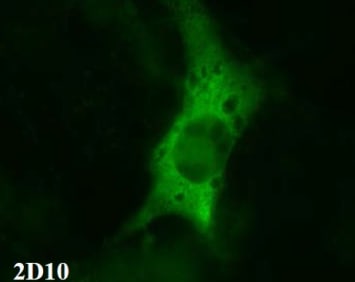Anti-Beta3 [7D1]
Invented at A*STAR Accelerate Technologies Pte Ltd
- Datasheet
- References (0)
- Inventor Info
Info
| Catalogue Number | 152635 |
| Applications | FACS IF WB |
| Antigen/Gene or Protein Targets | Beta3 subunit of high-voltage-gated calcium channel |
| Reactivity | Human |
| Relevance | Voltage-sensitive calcium channels (VSCCs) mediate the entry of calcium ions into excitable cells and are also involved in a variety of calcium-dependent processes, including muscle contraction, hormone or neurotransmitter release, gene expression, cell motility, cell division and cell death. Long-lasting (L-type) calcium channels belong to the 'high-voltage activated' (HVA) group. They are blocked by dihydropyridines (DHP), phenylalkylamines, benzothiazepines, and by omega-agatoxin-IIIA (omega-aga-IIIA). They are however insensitive to omega-conotoxin-GVIA (omega-ctx-GVIA) and omegaagatoxin-IVA (omega-aga-IVA). The overall conclusion is that deletion of the beta 3 subunit affects at least three distinct types of High voltage activated Ca2+ channel (L,N and P/Q types), but no single type of channel is solely dependent on beta 3. The beta3 (β3) subunit of high-voltage-gated calcium channels is a peripheral membrane protein that co-purifies with neural N-type calcium channels. Beta3 subunit contributes to the function of the calcium channel by increasing peak calcium current, shifting the voltage dependencies of activation and inactivation, modulating g protein inhibition and controlling the alpha-1 subunit membrane targeting. |
| Host | Mouse |
| Immunogen | GST-beta3 fusion protein |
| Subclass | IgG1 |
| Myeloma Used | Sp2/0-Ag14 |
| Research Area | Epigenetics & Nuclear Signalling, Neurobiology |
References
There are 0 reference entries for this reagent.
References: 0 entry
There is no reference for this reagent yet, feel free to use the button below to suggest one.
Add a reference
References: 0 entry
There is no reference for this reagent yet, feel free to use the button below to suggest one.
Add a reference


![Western blot was performed using anti-Beta3 [7D1] on non-transfected (-) and transfected (+) cell lysates.](https://res.cloudinary.com/ximbio/image/upload/c_limit,fl_lossy,h_282,q_auto,w_368/5ec1c39c-a58a-44f3-a227-eda9cc9c5516.jpg)

![Image thumbnail for Anti-Beta3 [7D1]](https://res.cloudinary.com/ximbio/image/upload/c_fit,fl_lossy,q_auto/5ec1c39c-a58a-44f3-a227-eda9cc9c5516.jpg)
![Image thumbnail for Anti-Beta3 [7D1]](https://res.cloudinary.com/ximbio/image/upload/c_fit,fl_lossy,q_auto/ff944ef7-da07-45fb-80a1-54fb972fee00.jpg)
![Image thumbnail for Anti-Beta3 [7D1]](https://res.cloudinary.com/ximbio/image/upload/c_fit,fl_lossy,h_45,q_auto/5ec1c39c-a58a-44f3-a227-eda9cc9c5516.jpg)
![Image thumbnail for Anti-Beta3 [7D1]](https://res.cloudinary.com/ximbio/image/upload/c_fit,fl_lossy,h_45,q_auto/ff944ef7-da07-45fb-80a1-54fb972fee00.jpg)
